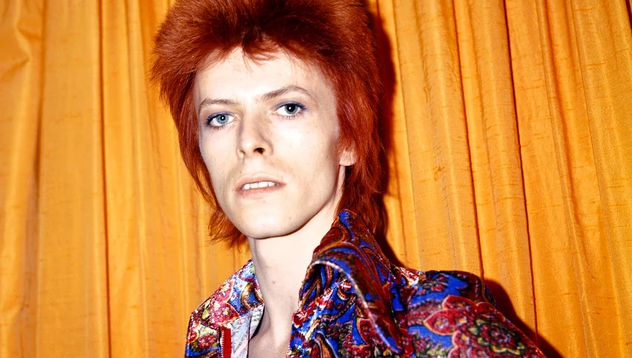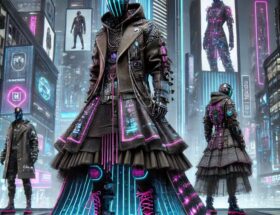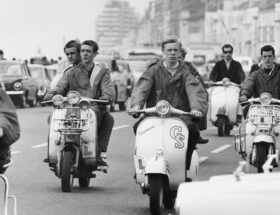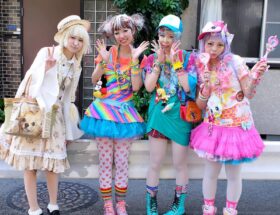David Bowie is widely recognized as one of the most influential and innovative artists of the 20th century. In addition to his groundbreaking musical contributions, Bowie also made a significant impact on the fashion world, using his style to push boundaries and challenge traditional notions of gender and identity. From his early career to his later years, Bowie’s fashion choices helped to define eras, inspire designers, and influence pop culture as a whole.
One of Bowie’s most iconic fashion moments came in the early 1970s, during the height of the glam rock era. At the time, traditional gender norms were still very much in place, with men expected to dress in suits and ties and women in dresses and skirts. But Bowie subverted these expectations with his androgynous look, wearing platform boots, colorful jumpsuits, and bold makeup. His persona as Ziggy Stardust, a rock star from outer space, took these fashion choices to the extreme, with the character’s bright red hair, glittery makeup, and futuristic costumes becoming instantly recognizable.
Bowie’s androgynous style was a powerful statement at a time when homosexuality was still criminalized in many parts of the world, and gender nonconformity was often met with hostility. But Bowie’s style helped to break down these barriers and challenge societal expectations of what it meant to be a man or a woman. His influence was particularly felt in the world of rock music, where many artists began to adopt similar looks and attitudes.
In the late 1970s, Bowie shifted his style once again, embracing a more minimalist and understated look that reflected the emerging punk and new wave movements. He began to wear slim-fitting suits, often in black or other dark colors, and combined them with white shirts and ties. This look, which was sometimes called the “Thin White Duke” style, was a stark contrast to the glitter and glam of his earlier years, but it was no less impactful. The style was sleek, elegant, and sophisticated, and it helped to set the tone for the fashion of the 1980s.
Bowie’s influence on fashion continued into the 1980s, as he experimented with a variety of styles and looks. He often wore oversized jackets and pants, combining them with bright colors and bold patterns. He also embraced the emerging trends of the time, such as the New Romantic movement, which was characterized by flamboyant clothing and makeup. Bowie’s embrace of these styles helped to popularize them and bring them into the mainstream.
In the 1990s, Bowie continued to push boundaries with his fashion choices. He often wore oversized coats and jackets, combined with baggy pants and colorful shirts. He also embraced the emerging grunge and alternative movements, wearing ripped jeans and flannel shirts. But even as he experimented with these new styles, he never lost his sense of style and sophistication. His ability to combine different elements and make them his own was a testament to his creativity and individuality.
David Bowie’s impact on the fashion world was not limited to his innovative style choices. He also challenged conventional ideas about beauty, using his fashion to express his individuality and push boundaries. He frequently experimented with makeup, wearing bold colors and exaggerated designs that emphasized his otherworldly persona. His use of makeup helped to popularize androgyny in fashion, as it blurred the lines between masculine and feminine beauty standards. This influence can still be seen in contemporary fashion, where gender-neutral and non-binary styles are becoming increasingly popular.
Bowie’s impact on fashion extended beyond his personal style, as he also collaborated with many designers and artists throughout his career. He frequently worked with Japanese designer Kansai Yamamoto, who created many of the iconic costumes for Bowie’s Ziggy Stardust persona. These costumes were inspired by traditional Japanese design, featuring intricate embroidery, bold colors, and exaggerated shapes. Bowie’s collaborations with Yamamoto helped to introduce Japanese design to the West, and his influence on fashion can still be seen in contemporary Japanese fashion and streetwear.
In addition to his collaborations with designers, Bowie also worked with many photographers and artists to create iconic images that helped to define his public persona. His most famous collaboration was with photographer Mick Rock, who captured many of Bowie’s most iconic moments on film. These images helped to solidify Bowie’s status as a fashion icon and cultural icon, as they captured the essence of his unique style and persona.
Bowie’s impact on fashion was not limited to his clothing and accessories. He also helped to popularize a variety of hairstyles, from the bright red mullet of Ziggy Stardust to the short, spiky blonde hair of the Thin White Duke. His hairstyles were often as influential as his clothing choices, and they helped to define eras and inspire new trends.
Bowie’s impact on fashion was also closely tied to his music, as his style often reflected the themes and messages of his songs. His early glam rock style, for example, was inspired by his interest in science fiction and his desire to create a persona that was both otherworldly and relatable. Similarly, his Thin White Duke persona was inspired by the emerging electronic music of the time, and his sleek and minimalist style reflected the futuristic sounds of his music.
Bowie’s fashion choices were also closely tied to his personal life, as he used his style to express his identity and explore his own sense of self. His androgynous style, for example, was a reflection of his own fluid sense of gender and sexuality, and his experimentation with makeup and hairstyles helped him to explore these aspects of his identity in a public way. His willingness to challenge traditional gender norms and express his own unique sense of self helped to inspire countless others to do the same.
Bowie’s impact on fashion can still be felt today, as his influence on pop culture continues to inspire new generations of artists and designers. His legacy has helped to shape the world of fashion in countless ways, from his androgynous style to his collaborations with designers and artists. His willingness to push boundaries and challenge conventional ideas about beauty and gender helped to open up new possibilities for self-expression and creativity, and his impact on the fashion world will continue to be celebrated for generations to come. His impact on pop culture as a whole is immeasurable, and his contributions to music, film, and fashion will continue to be celebrated for generations to come.
In conclusion, David Bowie’s impact on the fashion world cannot be overstated. His ability to push boundaries and challenge traditional notions of gender and identity helped to define eras, inspire designers, and influence pop culture as a whole. From his androgynous glam rock style to his sleek and sophisticated Thin White Duke look, Bowie’s fashion choices were always innovative, creative, and ahead of their time.








